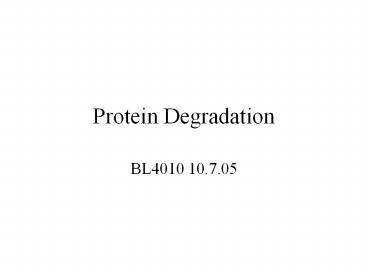Protein Degradation PowerPoint PPT Presentation
Title: Protein Degradation
1
Protein Degradation
- BL4010 10.7.05
2
Proteins have variable life-spans
EnzymeHalf-life Hours
Ornithine decarboxylase 0.2
RNA polymerase I 1.3
Tyrosine aminotransferase 2.0
Serine dehydratase 4.0
PEPcarboxylase 5.0
Aldolase 118
GAPDH 130
cytochrome c 150
3
Life-span factors
- Natural stability ("genetically encoded")
- an inherent biophysical characteristic
- Change in environment
- temperature
- pH
- Active degradation
- specific mechanism
- location
- partners
4
Terminology
- Half-life - Average time for half of the protein
pool to become denatured or degraded (depends on
what you measure) - Turnover - Lifespan of a protein from synthesis
to degradation - Stability - Subjective property of a proteins
natural tendency to denature under certain
conditions - Denaturation - Unfolding, partial or total of a
polypeptide - Degradation - Proteolysis of a peptide
- Ubiquitination Ubiquitylation
- Protease peptidase
5
Two routes to digest proteins
- Lysosomes
- Receptor mediated endocytosis phagocytosis
- Proteasomes for endogenous proteins
- transcription factors
- cell cycle cyclins
- virus coded proteins
- improperly folded proteins
- damaged proteins
- Cystic fibrosis is due to the accelerated
degradation of chloride transporter
6
Ubiquitin mediates degradation for many but not
all proteins
7
(No Transcript)
8
(No Transcript)
9
(No Transcript)
10
Ubiquitination
DEGRADATION
11
Ubiquitination
- Ubiquitinating enzymes E1,E2, E3 - thiol ester
bond - Final target - isopeptide bond between a lysine
residue of the substrate (or the N terminus of
the substrate) and ubiquitin
12
Ubiquitin
- 76 amino acids
- Highly conserved
- 3 amino acid changes yeast to human
- Thermostable
13
Ubiquitin is first activated
- Ubiquitin is adenylated
- Forms bond at Cys of E1 activating enzyme
- E1 transfers Ubq to E2 conjugating enzyme
14
Polyubiquitination
- E2 conjugating enzyme is bound by E3 ligase which
transfers Ubq to the target protein
15
(No Transcript)
16
(No Transcript)
17
Why have a 3-step ubiquitination process?
- Ubiquitin
- E1 (1)
- E2 (12-30)
- E3 (gt200?)
- HECT-type
- RING-type
- PHD-type
- U-box containing
18
N-termini
- Acidic N-termini
- Arg-tRNA protein transferase
- conversion of acidic N-terminus to basic!
- VAST MaGiC (Val, Ala, Ser, Thr, Met, Gly, Cys)
resistant to Ubiquinitation - WHEN sQuiDs FLY tend to have short half-lives (
lt30 min.)
19
Signals for degradation (degrons)
- PEST sequences (Pro, Glu, Ser, Thr)
- FREQK nonessential under starvation conditions
- DUBS (de-ubiquinating enzymes) provide additional
regulation
20
(No Transcript)
21
SUMOylation
- SUMO small ubiquitin related modifier (1996)
22
The proteasome
- Alfred Goldberg Martin Rechsteiner in 1980's
- Similar in structure to GroEL chaperone
- Unfolding and proteolysis
- Much more specific
- Why?
23
Eukaryotic Proteasome
- 26S (200 kD) complex
- 2OS (673 kD) proteasome or multicatalytic
protease complex (MCP) as the key proteolytic
component - 19S complex containing several ATPases and a
binding site for ubiquitin chains. - 19S particle "caps" each extremity of the 20S
proteasome - Unfolds the protein substrates
- Controls entry into the 20S proteasome
- Stimulates proteolytic activity
- In yeast, only 3 out of 7 subunits are
proteolytically active
24
(No Transcript)
25
(No Transcript)
26
Yeast proteasome
27
Bacterial proteasomes do not require ubiquitin
- T. acidophilum 20S proteasome
- 14 ?-subunits and 14 ?-subunits in a four stacked
ring - 2 outer rings of seven ? subunits/2 inner of
seven ? subunits - Central channel with three chambers
- 2 antechambers located on opposite sides of a
central chamber. - 14 catalytic sites within the central chamber
- N-terminal threonine is catalytic residue
- Covalent modification of Thr by lactacystin, a
natural inhibitor of the proteasome. - Unspecific proteolysis but products always 6 to 9
residues. This corresponds to the length between
adjacent catalytic sites in the central chamber
28
Thermoplasma proteasome
29
(No Transcript)
30
(No Transcript)
31
(No Transcript)
32
Other Proteases
- Cell cycle control/stress response proteases
- Proteasome
- HtrA
- Calcium activated proteases (Calpains)
- Apoptotic proteases
- ICE family (caspases)
- Autocatalytic proteases
- Nutrient regulated proteolysis (lysosome)
- Intramembrane cleave protease (ICLiPs)
33
What is proteolysis?
- Proteolysis peptide hydrolysis (facilitated
nucleophilic attack of water on peptide bond) - Four mechanistic categories of protease
- serine proteinases
- chymotrypsin family
- subtilisin family
- cysteine proteinases (e.g. papain, caspsases)
- aspartic proteinases (e.g. pepsin)
- metallo proteinases (e.g. thermolysin)
34
Htr Protease
serine protease (chymotrypsin family)
35
Unlike proteasome, most proteases are specific
36
Proteolysis as a regulatory mechanism
37
Proteolysis regulates cell death
38
Proteolysis as a regulatory mechanism
(sequestration of sterol response element
transcription factor)
39
Why make proteins that have short half-lives?
- It seems wasteful to try to maintain the
concentration of a protein while it is
simultaneously being degraded.

